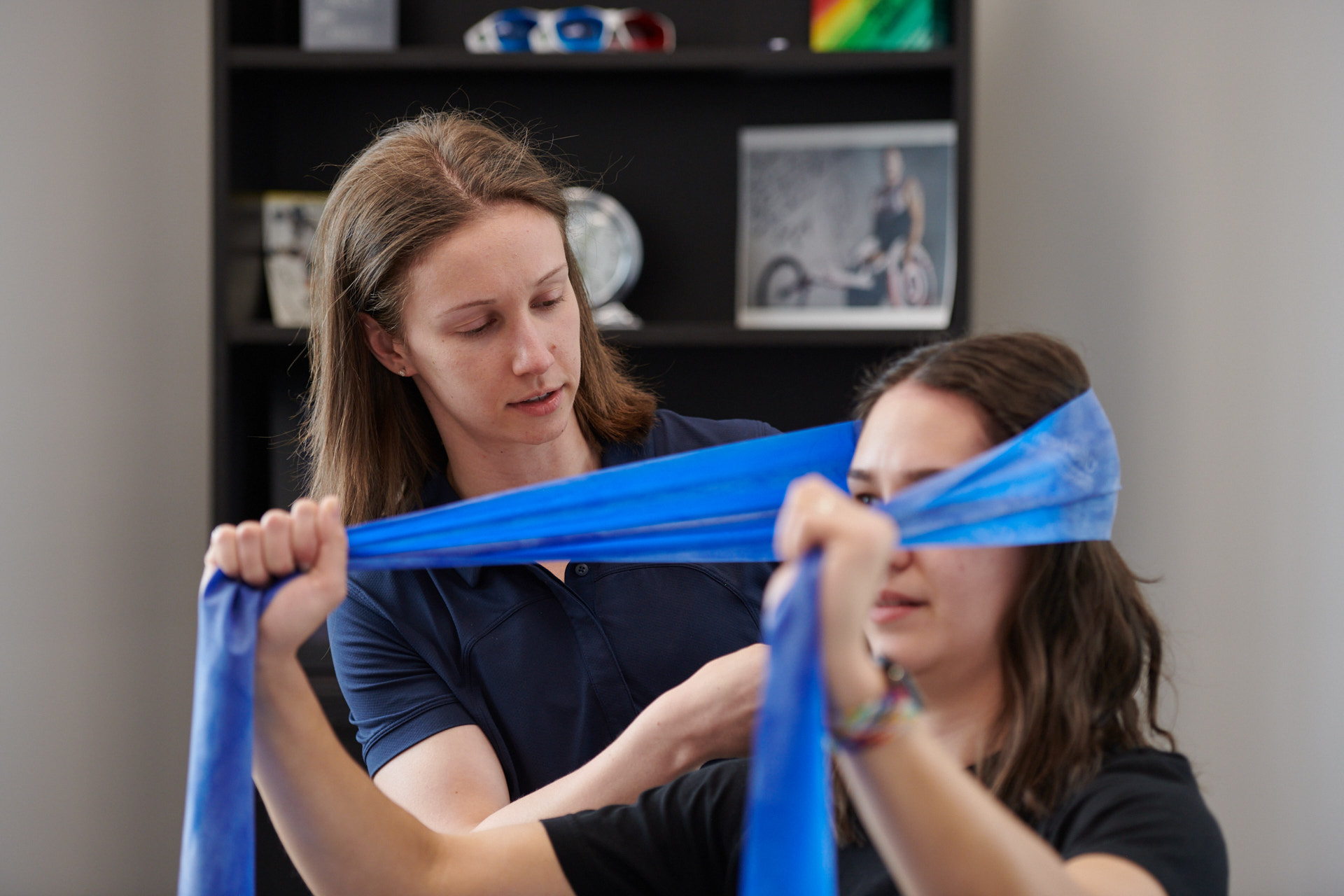Rehabilitation Options for Persistent Concussion Symptoms
Most individuals experience a full recovery from a concussion within a few weeks following the injury. However, for some, symptoms may persist longer, leading to what is known as “Persistent Post-Concussion Symptoms.” This term describes symptoms that continue beyond the first month after the injury and can include headaches, dizziness, cognitive difficulties, and mood disturbances.
Understanding Persistent Post-Concussion Symptoms
The reasons why some individuals experience longer recoveries while others recover more quickly are not fully understood. Factors such as the injury mechanism, genetic makeup, past concussion history, age, and developmental stage may play a role in recovery duration though more research is needed. Certain individuals, including those with a history of migraines, mood or sleep disorders, and high initial symptom severity, may be at greater risk for prolonged recovery. However, the presence of these factors does not necessarily guarantee a longer recovery.
It is essential to recognize that every concussion is unique, and the recovery timeline can vary from person to person. A proactive approach to treatment is crucial in helping those with Persistent Post-Concussion Symptoms regain function and return to normal activities. Early intervention can lead to faster recovery, reducing the likelihood of long-term difficulties.
The Invisible Injury
One of the challenges in treating concussions is that the injury is often invisible to others. Symptoms such as headaches, dizziness, fatigue, and concentration difficulties are internal and cannot be seen, making it difficult for family members, co-workers, teachers, or even some healthcare providers to recognize the scope of the injury. This lack of visibility is why concussions are often referred to as “the invisible injury.”
This can lead to feelings of isolation and frustration for those recovering from a concussion. It is not uncommon for individuals to feel overlooked or invalidated during their recovery process. This is why it’s essential to seek support from healthcare professionals that are specially trained in concussion management. Understanding the invisible nature of this injury is the first step toward developing effective treatment plans that address the specific needs of each patient.
The Importance of Early Intervention
The earlier a tailored treatment plan is implemented, the better the recovery outcomes. Research shows that delaying rehabilitation or adhering to outdated treatment models that emphasize complete rest for extended periods may actually slow recovery. Modern concussion rehabilitation approaches focus on gradually reintroducing physical and cognitive activities with the guidance of healthcare professionals, helping individuals regain function more quickly.
Concussion Subtypes and Treatment
Recent research has shown that concussions often follow certain symptom patterns, referred to as concussion “subtypes.” These subtypes include vestibular, ocular, cervical, mood, and cognitive subtypes, among others. By identifying the specific subtype or combination of subtypes, healthcare providers can create individualized treatment plans to target the underlying cause of symptoms. These plans often involve multiple healthcare disciplines, such as physical therapy, occupational therapy, and mental health support, ensuring a holistic approach to recovery.
Each person’s recovery path is different, but recognizing and addressing concussion subtypes early in the rehabilitation process can significantly improve recovery time and reduce the risk of Persistent Post-Concussion Symptoms.
Multimodal Rehabilitation Strategies
There is no one-size-fits-all solution for concussion rehabilitation. Treatment is typically multimodal, involving various strategies tailored to each patient’s needs. Below are some key components of concussion rehabilitation:
Neck Rehabilitation
Since concussions often occur alongside neck injuries, addressing the cervical spine is crucial for symptom relief. Neck injuries can contribute to headaches, dizziness, balance difficulty and even cognitive challenges. Neck rehabilitation may include manual therapy to reduce muscle tension and improve joint mobility, as well as specific exercises to strengthen neck muscles and enhance joint proprioception and overall function. Regulated Healthcare providers such as Physiotherapists, Chiropractors, and Registered Massage Therapists are highly trained to carefully assess and address conditions such as whiplash and headaches arising from injury to the neck (cervicogenic headaches).
Vestibular and Ocular Rehabilitation
Dizziness and balance problems are common after a concussion and may indicate vestibular or ocular dysfunction. These systems, which are responsible for spatial orientation and processing of visual information, can be disrupted following a head injury. Vestibular-ocular rehabilitation focuses on exercises designed to retrain the brain’s ability to process motion, balance, and visual stimuli. For more complex visual or balance issues, collaboration with a Specialized Optometrist or Audiologist may be necessary.
By addressing vestibular and ocular problems early in the rehabilitation process, patients can improve their balance, reduce dizziness, and enhance visual coordination, all of which are crucial for returning to daily activities. Many health professionals who specialize in concussion rehabilitation receive specific training that allows them to effectively assess and treat vestibular and ocular challenges.
Aerobic Exercise
In the past, it was thought that complete rest was essential for recovery after a concussion. However, new evidence suggests that early, controlled aerobic exercise can aid in recovery. Engaging in light physical activity, such as walking or stationary cycling, can improve blood flow to the brain and help regulate autonomic functions, which are often disrupted after a concussion. It’s important to work with a healthcare provider to ensure that exercise is introduced gradually and at the appropriate intensity.
Light aerobic exercise, such as a daily walk or stationary cycling for 20-30 minutes, can be a good starting point for those in the early stages of concussion recovery. Supervised exercise programs, where patients gradually increase their activity level under the guidance of a trained professional, are another effective option.
Functional Rehabilitation
Functional rehabilitation involves exercises that engage multiple sensory systems simultaneously. For example, tasks that combine balance, vision, and movement help reintegrate the brain’s coordination of these systems. By challenging the brain in a controlled environment, functional rehabilitation can lead to better outcomes in returning to daily activities and work.
Cognitive Rehabilitation
Concussions often result in cognitive difficulties, including trouble concentrating, memory problems, and mental fatigue. These challenges can stem directly from the injury itself or from secondary factors like sleep disruption, anxiety, or depression.
Managing secondary factors that may be contributing to cognitive fatigue is a critical component of concussion rehabilitation. This might involve pain-reduction strategies, sleep counselling and behaviour modifications, rehabilitation for visual or vestibular complaints, or assistance with mood disorders. Cognitive compensation and remediation strategies focus on optimizing brain function through strategies like schedule regulation, task prioritization, and cognitive exercises where appropriate. Consulting with an Occupational Therapist, Psychologist, Psychotherapist, or Registered Social Worker may be needed to assist with persistent cognitive difficulties.
Early intervention for cognitive complaints is crucial to help individuals return to work or school with minimal disruptions. Developing accommodations and pacing strategies can allow patients to gradually reintegrate into their regular routines without overwhelming their symptoms.
Mental Health Support
Mental health concerns, including anxiety, depression, and social withdrawal, are common after a concussion. These issues can exacerbate symptoms and delay recovery if not addressed. Mental health support, including psychotherapy, counseling, and mindfulness practices, can help patients develop healthy coping mechanisms and manage their emotional well-being.
Early intervention in mental health is critical, as untreated anxiety or depression can prolong recovery and contribute to Persistent Post-Concussion Symptoms.
Seeking Further Help
For those experiencing prolonged symptoms, working with a concussion specialist or multidisciplinary team is essential. Personalized, early, and multimodal treatment can expedite recovery and help individuals return to their regular activities sooner. The sooner treatment begins, the more likely it is that recovery will occur without long-term suffering.
Concussion rehabilitation is an evolving field, with research continually revealing new ways to promote recovery. Early intervention and an individualized approach to treatment can make a world of difference for those affected by this invisible injury. If you or a loved one are dealing with a concussion, don’t hesitate to reach out to a healthcare provider experienced in concussion management for guidance and support.
References
- Reid SA, Farbenblum J, McLeod S. Do physical interventions improve outcomes following concussion: a systematic review and meta-analysis? Br J Sports Med. 2022 Mar;56(5):292-298.
- Patricios JS, Schneider KJ, Dvorak J, et al. Consensus statement on concussion in sport: the 6th International Conference on Concussion in Sport-Amsterdam, October 2022. Br J Sports Med. 2023 Jun;57(11):695-711.






